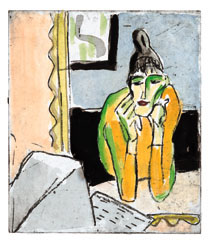![]()
Main Menu · Search · Current Issue · Contact · Archives · Centennial · Letters to the Editor · FAQs
![]()
Main Menu · Search · Current Issue · Contact · Archives · Centennial · Letters to the Editor · FAQs
 |
The Union Catalog of the Harvard University Library was a mighty piece of technology from 1915, when it was installed, to this decade, when it became obsolete. It enabled (theoretically) a user standing in Widener Library to discover in the catalog's serried ranks of card files whether a wanted piece of printed matter existed in any Harvard library. When the Harvard OnLine Library Information System (hollis) digitized the Union Catalog, you, reader, seated at your home computer, could see whether the book you wanted was among the 13.5 million volumes housed today in the nearly 100 libraries that comprise the University Library. Moreover, you could tell whether the book had been checked out. Now the plan is to make a digital union catalog of visual resources in Harvard's libraries and museums.
In 1970 Sidney Verba '53, now Pforzheimer University professor and director of the University Library but then a faculty member at the University of Chicago, ran a summer political-science project at Harvard's Semitic Museum, a building that also housed the Center for International Affairs. A week after Verba's program was over, he reports, a powerful bomb exploded on the top floor, where his office had been, presumably detonated as an anti-war protest (the Center had once harbored Henry Kissinger). The blast blew a hole in the ceiling, and down rained early views of Palestine, part of a collection of such things, subsequently become famous, that no one knew was in the museum's attic. Harvard has an estimated eight million images in 54 repositories. About half of them are individually cataloged; the rest are cataloged as batches of stuff in archives--87 postcards of Tangier in the Fine Arts Library, that sort of thing. One can be certain that there are many wonderful visual resources at Harvard of which no one, or almost no one, is aware.
The Harvard Union Catalog of Visual Resources will change that situation. With it (theoretically), a single search will find any image of Kierkegaard or Kilimanjaro or kitchenware in any Harvard collection.
The visual resources catalog has been in the planning stage for about a year, and in February those librarians and museum people and others who have been working on it staged a day-long symposium in Lamont Library for colleagues and other interested parties to tell what they had accomplished, to brace library staff for what the future holds, to darken the room and demonstrate a prototype (with thumbnail reproductions of images alongside catalog copy), to explain the techniques by which the catalog will be assembled and work, and to explore areas of particular concern, such as protecting intellectual property rights.
The project is now in the definition phase, in which standards and functional requirements are being clarified among participants. A pilot implementation of the catalog will go on-line next fall, says Dale Flecker, associate director for planning and systems in the University Library, which will develop and maintain the catalog. He anticipates that by the fall of 1999 all of Harvard's visual collections will be participating. The intensity of participation will depend upon money, time, will, and decisions about those things made by the keepers of the various collections.
Robert Cook '68, Arnold professor and director of the Arnold Arboretum (which has many photographs from expeditions to Asia early in the century, with negatives ready for digitizing and a database ready to be dumped into a catalog as proposed), said at the symposium that before it is fully realized, the collaborative effort will require "leadership from deans and directors, a willingness to meet substantial costs, skill to avoid the numerous political bear traps into which one might step, and patience."
Verba verbally rubbed his hands together in satisfaction at the opening of the symposium. "The visual resources union catalog is a reaction to a change in scholarship--a decline in boundaries," he said. "The German model of specialization embraced by President Eliot's University helped create at Harvard many boundaries--among disciplines, buildings, and different communications media. The University's organizing principle, Every Tub on Its Own Bottom, defines a world of boundaries." Verba granted that the "idea of separate institutions is sometimes very good, but users of libraries, for instance, couldn't care less about it. And shouldn't. This project is an example of how we have learned to cooperate. We are breaking down boundaries. Digital information moves easily across them."
Martha Mahard, acting librarian of the Fine Arts Library and a major player in the project, said that once, at a gathering in the Copley Plaza Hotel ballroom, a colleague from another part of the University had complained to her, "At Harvard, we never talk to each other." "Those working on the union catalog of visual resources," said Mahard, "have been trying to correct this communications failure. We can no longer afford to sit on our own bottoms."
Main Menu · Search · Current Issue · Contact · Archives · Centennial · Letters to the Editor · FAQs
![]()